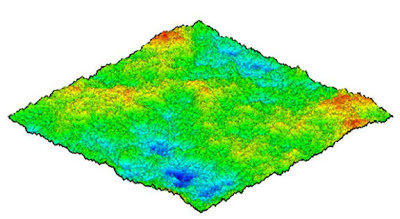
In experiments mimicking the speed of earthquakes, geophysicists at Brown University detail a phenomenon known as flash heating. They report in a paper published in Science that because fault surfaces touch only at microscopic, scattered spots, these contacts are subject to intense stress and extreme heating during earthquakes, lowering their friction and thus the friction of the fault. The localized, intense heating can occur even while the temperature of the rest of the fault remains largely unaffected.
Most earthquakes that are seen, heard, and felt around the world are caused by fast slip on faults. While the earthquake rupture itself can travel on a fault as fast as the speed of sound or better, the fault surfaces behind the rupture are sliding against each other at about a meter per second.
But the mechanics that underlie fast slip during earthquakes have eluded scientists, because it’s difficult to replicate those conditions in the laboratory. “We still largely don’t understand what is going at earthquake slip speeds,” said David Goldsby, a geophysicist at Brown, “because it’s difficult to do experiments at these speeds.”
Now, in experiments mimicking earthquake slip rates, Goldsby and Brown geophysicist Terry Tullis show that fault surfaces in earthquake zones come into contact only at microscopic points between scattered bumps, called asperities, on the fault. These tiny contacts support all the force across the fault. The experiments show that when two fault surfaces slide against other at fast slip rates, the asperities may reach temperatures in excess of 2,700 degrees Fahrenheit, lowering their friction, the scientists write in a paper published in Science. The localized, intense heating can occur even while the temperature of the rest of the fault remains largely unaffected, a phenomenon known as flash heating.
“This study could explain a lot of the questions about the mechanics of the San Andreas Fault and other earthquakes,” said Tullis, professor emeritus of geological sciences, who has studied earthquakes for more than three decades.
The experiments simulated earthquake speeds of close to half a meter per second. The rock surfaces touched only at the asperities, each with a surface area of less than 10 microns — a tiny fraction of the total surface area. When the surfaces move against each other at high slip rates, the experiments revealed, heat is generated so quickly at the contacts that temperatures can spike enough to melt most rock types associated with earthquakes. Yet the intense heat is confined to the contact flashpoints; the temperature of the surrounding rock remained largely unaffected by these microscopic hot spots, maintaining a “room temperature” of around 77 degrees Fahrenheit, the researchers write.
“You’re dumping in heat extremely quickly into the contacts at high slip rates, and there’s simply no time for the heat to get away, which causes the dramatic spike in temperature and decrease in friction,” Goldsby said.
“The friction stays low so long as the slip rate remains fast,” said Goldsby, associate professor of geological sciences (research). “As slip slows, the friction immediately increases. It doesn’t take a long time for the fault to restrengthen after you weaken it. The reason is the population of asperities is short-lived and continually being renewed, and therefore at any given slip rate, the asperities have a temperature and therefore friction appropriate for that slip rate. As the slip rate decreases, there is more time for heat to diffuse away from the asperities, and they therefore have lower temperature and higher friction.”
Flash heating and other weakening processes that lead to low friction during earthquakes may explain the lack of significant measured heat flows along some active faults like the San Andreas Fault, which might be expected if friction was high on faults during earthquakes. Flash heating in particular may also explain how faults rupture as “slip pulses,” wrinkle-like zones of slip on faults, which would also decrease the amount of heat generated.
If that is the case, then many earthquakes have been misunderstood as high-friction events. “It’s a new view with low dynamic friction. How can it be compatible with what we know?” asked Tullis, who chairs the National Earthquake Prediction Evaluation Council, an advisory body for the U.S. Geological Survey.
“Flash heating may explain it,” Goldsby replied.
The U.S. Geological Survey funded the research.
Note : The above story is reprinted from materials provided by Brown University.










